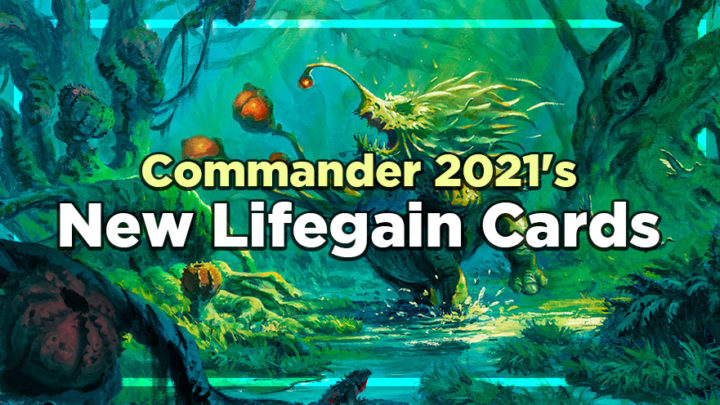Strixhaven, like every new Magic set, is designed with its own set of mechanical themes. But after nearly three decades, most have been revisited many times, reappearing in Standard over and over in slightly different forms. I think one of the coolest things to do with a Commander deck is to gather up these different incarnations of a theme and unite them in a single “greatest hits”-style synergy pile: the platonic ideal of an Equipment deck, or a flicker deck, or a lifegain deck.
Lifegain is the major theme being presented in the Witherbloom Witchcraft Commander precon, since both black and green have plenty of history with gaining life. The whole deck is bursting with powerful, high-potential effects. But more than just power level, these designs show how even a notoriously weak mechanic can be brought to uh… life.
THE HIGH LIFE IS OVERRATED
Despite being a high-profile part of the game since Alpha, lifegain as a mechanic remains awkward to design around. Its reputation as a “trap” for newer players is well earned; while gaining a ton of life feels like a good defensive move, spending resources to “buy time” while your opponent spends theirs to actually advance a game plan will rarely work out. This has only become truer over time, as modern design emphasizes access to spells and a high-tempo game, even for decks like red aggro.
Because of this, cards which “only” gain life are now rarely printed, if ever. Lifegain tends to be either incidental on removal or other proactive spells, or come in the form of lifelink. Lifelink in particular is a great example of how much better lifegain is for an aggressive deck, letting you race other damage-based decks without care. “Just buying time” makes more sense when you’re already close to winning!
But the very low value of lifegain “on its own” can make it an incredibly powerful design tool. Especially in a synergy-rich environment like Commander, life totals feel closer to the energy mechanic from Kaladesh — an alternate resource which can be given and taken from players freely without destabilizing other areas of balance.
MORTGAGING MORTALITY
Life manipulation is easy to design cards around because, unlike energy, every deck will have some — and almost every opponent can interact with it. It’s also easy to give and take away in large quantities, multiply or divide. It can even be templated onto any sort of card, unlike counters, which need to be assigned to players or permanents. I’ve talked before about the importance of alternative resources in unlocking tempo plays, especially for colors like white and black which can struggle to accelerate their resources otherwise. Coincidentally, both colors have broad access to lifegain!
These new Witherbloom cards embrace the idea of life as a fluid, transferable resource, embodying a fine control over the barrier between life and death. Along with creating and sacrificing creatures (which the deck also does plenty of!), it’s the most flavorful expression of the GB color combination possible — something I’m glad to see in main set Witherbloom cards as well! Alternatively, life manipulation could be a theme tying together Witherbloom and Silverquill into some powerful three-color archetype, even in Standard.
A PERFECT PRECON?
But while green has plenty of ways to gain life, I would have struggled to fill out a full “GB Lifegain” Commander list – before now. WotC had one precon to print enough fresh cards to make this deck sing, and they didn’t just manage that — these new spells are a perfect showcase for the intricate and exciting card designs this mechanic can allow for. Let’s take a look at all the goodies:
EZZAROOT CHANNELER

The key to the coolest Commander precon in years is that any type of card can be built to utilize life as a common resource. Ezzaroot Channeler could simply have been a mana dork that taps for GG and discounts creature spells by two. But because it’s so easy to template, and adding two life is not so valuable that it raises the cost of the effect, this card can be strong on its own while interfacing powerfully, flexibly and seamlessly with hundreds of other effects.
My only knock on Channeler specifically is the somewhat high cost, but it has to be to justify the massive combo potential of any such mana-discounting effect. And as we saw with Nyxbloom Ancient, “infinite combo enabler” is a fine way to tempt people into the paradox of a curve-topping mana dork.
MARSHLAND BLOODCASTER
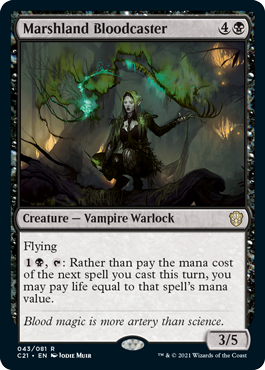
This black counterpart of Ezzaroot Channeler has a more in-color take on “use lifegain to negate mana costs.” In this case, we spend that excess life instead of profiting directly off its gain, but in return, the ability is more flexible and powerful, freecasting any spell we like! Sadly, according to the ruling of helpful judges on Twitter, this ability counts as an alternative cost; it cannot be used to pay for X-costs, and can’t be used if you’re already casting a spell for a different alternative cost such as flashback or overload (kicker still works, though you’d have to pay mana for that).
TIVASH, GLOOM SUMMONER
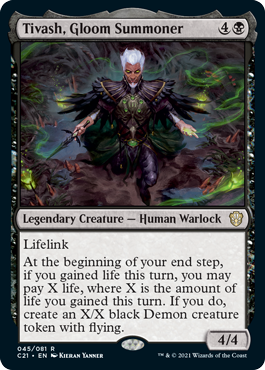
Another design advantage of lifegain as a resource/enabler is there are subtly different ways for cards to leverage it. You have triggers whenever life is gained, which can either be worded to incentivize gaining life in large bursts or one point at a time. Then there’s cards which “switch on” when your life total is high, cards which let you spend life like Witherbloom’s own founder dragon, and cards which retroactively count how much life you’ve gained this turn.
Each of these options gently tweaks how you evaluate your other card choices, but they are all at least somewhat synergistic so long as you’re gaining life — a far more interesting deckbuilding puzzle than a binary condition like companions. You can even combine these different clauses to further complicate the puzzle, as we see here with Tivash, Gloom Summoner.
Like many other cards in this precon, Tivash’s lifelink gives him a way to be self-sufficient without other sources of lifegain — while still scaling very well when they’re present. As a designer, I like that you don’t choose exactly how much life to pay, instead giving all or nothing from the amount you gained this turn. Choice is exciting, and cards which are too flexible or lack downside leave us without choices. While this effect will play a little differently every game, you’re at least always getting a Demon of some size, so players can choose how complex they want to get and not feel left out.
VEINWITCH COVEN
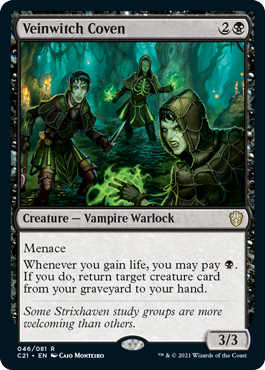
Cards like this attract my interest because they’re right at the crossroads of Commander and Legacy evaluation: a powerful card advantage engine at playable cost, on a sizable (yet Bolt-able) body. While some players might be disappointed this doesn’t return things directly to the battlefield, the softer effect means we get a powerful engine to slot in lower on the curve, which I love. There’s also certain payoffs for cards that can cheaply loop creatures to hand — check out Tortured Existence decks in Pauper if you need some inspiration.
The creature type isn’t the focus for this precon, but Vampires are the right tribal deck to generate a ton of triggers for this effect. Don’t sleep on the chance to buy back a bloodsucker for every lifelink hit!
BLIGHT MOUND
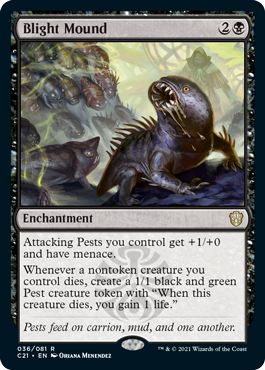
These sorts of “sac a creature, get a creature” payoffs are some of the most powerful effects for GB commanders in my experience, and at mana value 3 on a survivable (i.e. non-creature) permanent, I’m already pretty excited. What’s really nice is how much WotC were able to personalize this effect for Witherbloom!
Menace and +1/+0 is a perfect buff to give a wide team of tokens, ensuring half of them get through on each attack while you promptly sacrifice the blocked ones for value. It’s powerful enough to send me looking for other Pest-generating Witherbloom cards from the main set, without necessarily needing any of them to be worthwhile on its own.The fact that Pests can be killed on cue for one life makes them perhaps the most optimal way to manage the other effects in the deck, so even if you turn your nose up at the idea of creature combat, there’s plenty here to love!
ESSENCE PULSE

It’s awesome to see the variety of effects the designers of this deck were able to tie back into lifelink, creating combinations we aren’t used to seeing. Board wipes which can scale to the size of your opponents’ board are great for Commander, particularly when you don’t have to scale up the mana cost or when you get to customize the effect in the moment. In a lifegain-focused deck, Essence Pulse is both!
I especially like how this plays with lifelink creatures. You’ll often commit to a “why not” attack if you’re about to cast a sweeper in your second main phase, and even a few small lifelink hits will ensure a lethal X value for Essence Pulse at no real cost.
BLOSSOMING BOGBEAST

Another totally unique lifegain payoff! Again, this is useful by itself and gets better with other lifegain effects — especially in the “Soul Sisters” archetype, where you gain life efficiently by also going wide on board. Assuming you can keep it alive to the attack step, Blossoming Bogbeast will generate a tremendous team-wide pump with no trouble at all, letting your Oketra’s Monument tokens (or whatever foot soldiers you prefer) kill the whole table.
SPROUTBACK TRUDGE
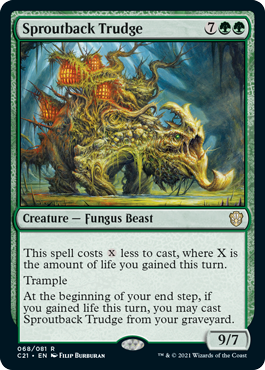
Anyone who has played with cards like Gravecrawler knows you shouldn’t underestimate the ability to re-cast a card indefinitely from the graveyard. And this one is a lot bigger than the Zombie, especially for something that will often only cost GG! I’m almost interested to see if this could be figured into Legacy somewhere, given that there are plenty of ways to generate life off a fattened graveyard.
Even a body of this size might not be a game-ending threat at the Commander table, but it does offer green decks a backdoor way to convert lifegain into cards and other resources — something it struggles to do compared to black. This big fungus can be easily fed to Greater Good or the like every turn, helping your lifegain deck go over the top even against decks that aren’t trying to damage you.
TRUDGE GARDEN

Green has had almost no direct payoffs for lifegain until Strixhaven, despite having plenty of incidental lifegain on its cards over the years. It was even the secondary color WotC shifted Soul Warden to during Planar Chaos, demonstrating a high potential for such effects in the color. Now, we get an extremely powerful Essence Warden payoff. Triggering from any amount of lifegain makes this very easy to utilize, even for decks focused more on token generation. The chunky 4/4 tokens are also good enough for a lifegain-focused deck to lean on without additional support.
I also like the distribution of mana investment here between the casting cost and trigger cost. 2G is very low for a card which can singlehandedly win the game like this, while two mana is cheap enough to reliably pay even if you had to use some mana to gain life in the first place (or to pay for multiple tokens per turn). That’s by conservative, Legacy/cEDH standards; in your average casual Commander game, I can easily see this pumping out 20 power worth of Beasts per turn cycle.
WILLOWDUSK, ESSENCE SEER
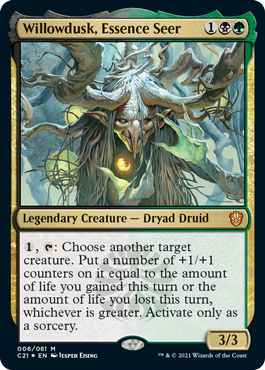
When I saw Willowdusk spoiled, I immediately knew this was the main commander for the precon without looking – which is a powerful thing to be able to convey just from a design. But her effect is flavorful, flexible and powerful enough to justify the position, synergizing with almost anything else in the precon and plenty more besides.
As with everything else below four mana, I also have half an eye on this for competitive Constructed; the gap between Commander, cEDH and Legacy card evaluations can be smaller than you’d think. Dark Depths proves how happy Legacy players are to produce 20/20 attackers at their opponent’s end of turn, and thanks to the “or the amount of life you lost” clause, this could easily make some Inkmoth Nexus lethally large — assuming you have a way to pay life. Following the logic I employed for Sproutback Trudge above, you could also turn the life loss back into life (or cards) fairly easily, an exchange which Children of Korlis proves can be valuable even without further manipulation.
WITCH’S CLINIC
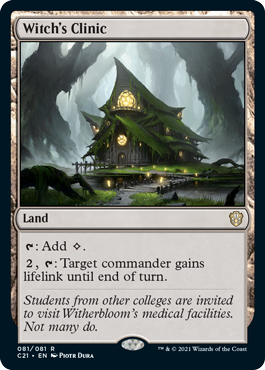
While I’m not a fan of watering down the color pie, I do think that a bit of lifelink on colorless cards is good for the game; Batterskull, Basilisk Collar and Shadowspear have all created interesting opportunities for me in the past. Getting an ability like this on a land is even more interesting, and I fully support the increasing occurrence of affordable, useful niche utility on colorless lands. It both enhances mono-color decks, which are able to play these colorless lands in greater numbers, and gives decks without easy access to card draw the ability to use mana productively every turn.
Witch’s Clinic addresses both of these urgent gaps in power level, but is still a card which can be played in any color identity; it’s left up to the player to try and reconcile it with their mana base, if they want it. Again, nuance over black-and-white playability makes me very happy.
LIFE IS WHAT YOU MAKE IT
If you’re now as excited as I am to splash around and build a GBx lifegain deck from these cards, then WotC have really hit this one out of the Mage’s Tower stadium. For a perennially underpowered mechanic, it only took one precon’s worth of new cards to get my cynical self on board the gain-train. Better still, all of them have depth and interest beyond the “do the thing, draw a card” payoffs that have drawn critique in past sets.
I definitely attribute part of this success to the inherent coolness and design strengths of lifegain, and I hope that this bold use of the mechanic doesn’t just go away after Strixhaven. But I think the Witherbloom Witchcraft and (equally groundbreaking) Lorehold Legacies precon decks are good signs for things to come, a noticeable and welcome upturn in the “sweet new cards I’m excited to play with” metric after years of decline. If WotC is determined to give us a constant stream of new Commander-focused cards, let them be like this set; opening up new design space to explore around old and beloved mechanics.

Tom’s fate was sealed in 7th grade when his friend lent him a pile of commons to play Magic. He quickly picked up Boros and Orzhov decks in Ravnica block and has remained a staunch white magician ever since. A fan of all Constructed formats, he enjoys studying the history of the tournament meta. He specializes in midrange decks, especially Death & Taxes and Martyr Proc. One day, he swears he will win an MCQ with Evershrike. Ask him how at @AWanderingBard, or watch him stream Magic at twitch.tv/TheWanderingBard.

